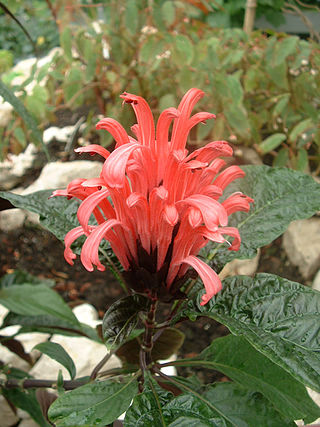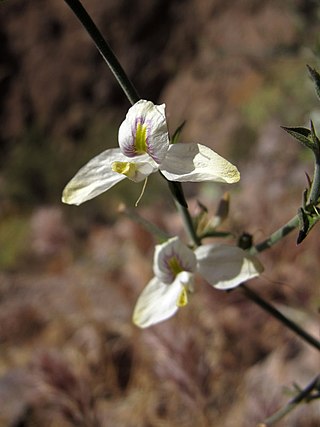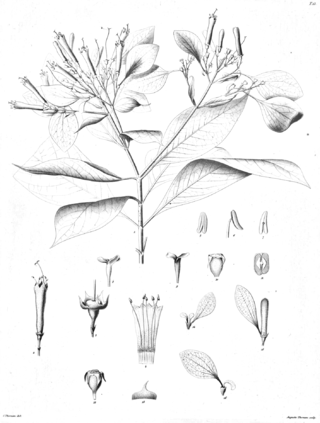
Acanthaceae is a family of dicotyledonous flowering plants containing almost 250 genera and about 2500 species. Most are tropical herbs, shrubs, or twining vines; some are epiphytes. Only a few species are distributed in temperate regions. The four main centres of distribution are Indonesia and Malaysia, Africa, Brazil, and Central America. Representatives of the family can be found in nearly every habitat, including dense or open forests, scrublands, wet fields and valleys, sea coast and marine areas, swamps, and mangrove forests.

Nothofagus, also known as the southern beeches, is a genus of 43 species of trees and shrubs native to the Southern Hemisphere in southern South America and east and southeast Australia, New Zealand, New Guinea, and New Caledonia. The species are ecological dominants in many temperate forests in these regions. Some species are reportedly naturalised in Germany and Great Britain. The genus has a rich fossil record of leaves, cupules, and pollen, with fossils extending into the late Cretaceous period and occurring in Australia, New Zealand, Antarctica, and South America.

Justicia is a genus of flowering plants in the family Acanthaceae. It is the largest genus within the family, encompassing around 700 species with hundreds more as yet unresolved. They are native to tropical to warm temperate regions of the Americas, India, and Africa. The genus serves as host to many butterfly species, such as Anartia fatima. Common names include water-willow and shrimp plant, the latter from the inflorescences, which resemble a shrimp in some species. The generic name honours Scottish horticulturist James Justice (1698–1763). They are closely related to Pachystachys.

Chrysochlamys is a plant genus of the family Clusiaceae. It includes 36 species native to the tropical Americas, ranging from southern Mexico to Bolivia and northern Brazil.

Ruellia is a genus of flowering plants commonly known as ruellias or wild petunias. They are not closely related to petunias (Petunia) although both genera belong to the same euasterid clade. The genus was named in honor of Jean Ruelle (1474–1537), herbalist and physician to Francis I of France and translator of several works of Dioscorides.

Stenandrium is a genus of flowering plants in the family Acanthaceae native to the Americas, with 50 species of perennial herbs ranging from the southern United States to northern Argentina and central Chile.

Anisotes is a genus of Afrotropical plants in the family Acanthaceae. The genus is morphologically similar to Metarungia, from which it differs mainly in the dehiscence of the fruit capsule, and the nature of the placenta. Placentas remain attached to the inner surface of fruit capsules in Anisotes.

Carlowrightia is a genus of flowering plants in the bear's breeches family, Acanthaceae. Members of the genus, commonly known as wrightworts, are mainly small shrubs bearing inflorescences of lily-like flowers. They are native to the Americas, ranging from the southwestern United States through Mexico and Central America, and in Ecuador. Many species are native to western North America. The genus was named for the American botanist Charles Wright.

Odontonema, the toothedthreads, is a genus of flowering plants in the family Acanthaceae. It is native to Central America.

Stenostephanus is a genus of plants in the family Acanthaceae.

Nothofagus cliffortioides, commonly called mountain beech, is a species of Southern beech tree and is endemic to New Zealand. Mountain beech grows in mountainous regions at high elevations. In New Zealand the taxon is called Fuscospora cliffortioides. Nothofagus cliffortioides occupies a wider range of habitat than any other New Zealand tree species and it shows a corresponding range of life form, seeding habits, regenerative patterns, growth habits, growth rates, stand replacement and mortality patterns.
Stenandriopsis is a genus of flowering plants belonging to the family Acanthaceae. It includes 20 species native to tropical Africa and Madagascar. Molecular phylogenies have placed the Old World Stenandriopsis apart from New World Stenandrium, and the genus is accepted in a classification of the family Acanthaceae published in 2022.
Barleriola is a genus of flowering plants belonging to the family Acanthaceae.
Champluviera is a genus of flowering plants belonging to the family Acanthaceae.
Holographis is a genus of flowering plants belonging to the family Acanthaceae.

Lamourouxia is a genus of flowering plants belonging to the family Orobanchaceae.

Louteridium is a genus of flowering plants belonging to the family Acanthaceae.
Mexacanthus is a genus of flowering plants belonging to the family Acanthaceae.
Mirandea is a genus of flowering plants belonging to the family Acanthaceae.

Pogonopus is a genus of flowering plants belonging to the family Rubiaceae.













